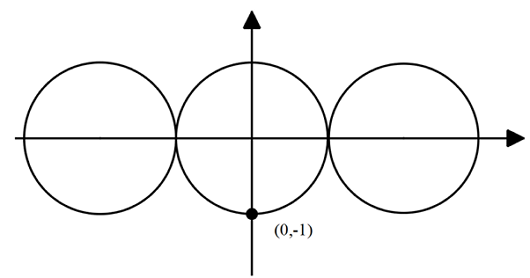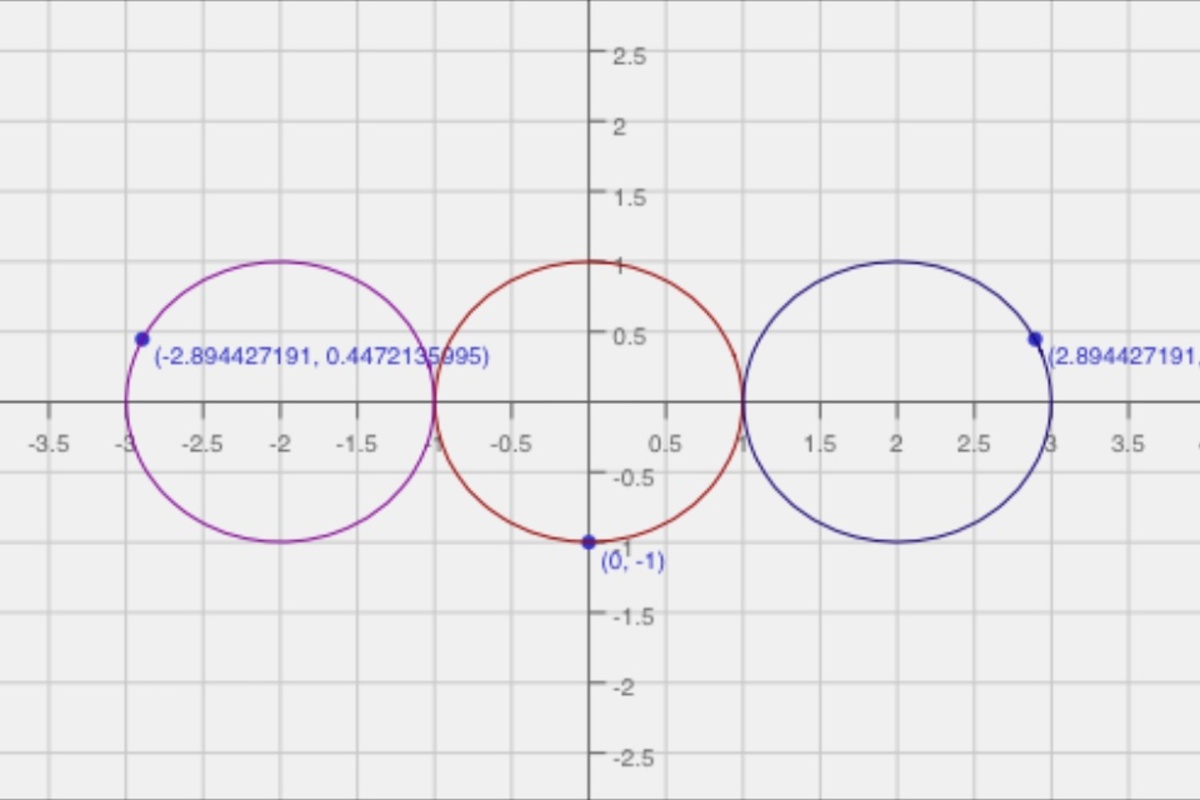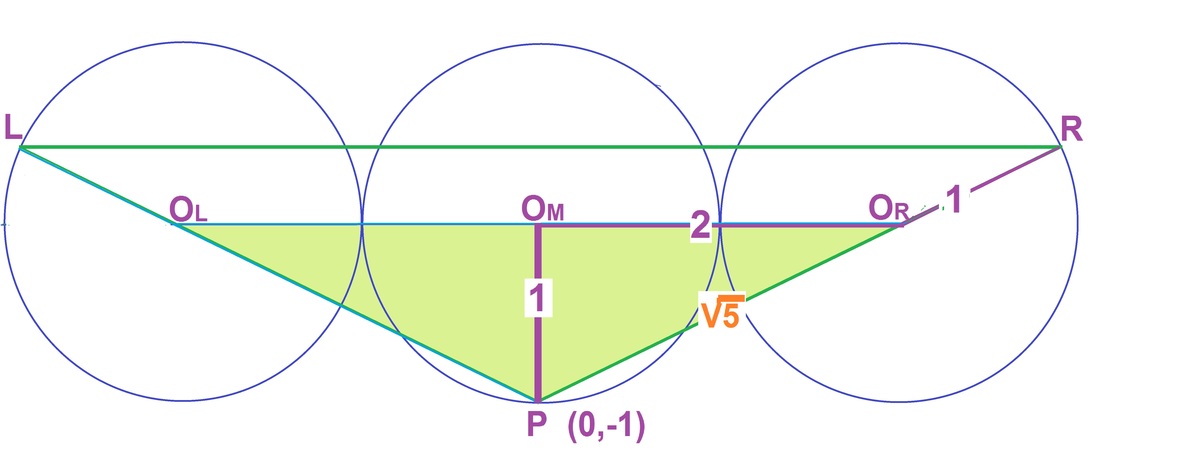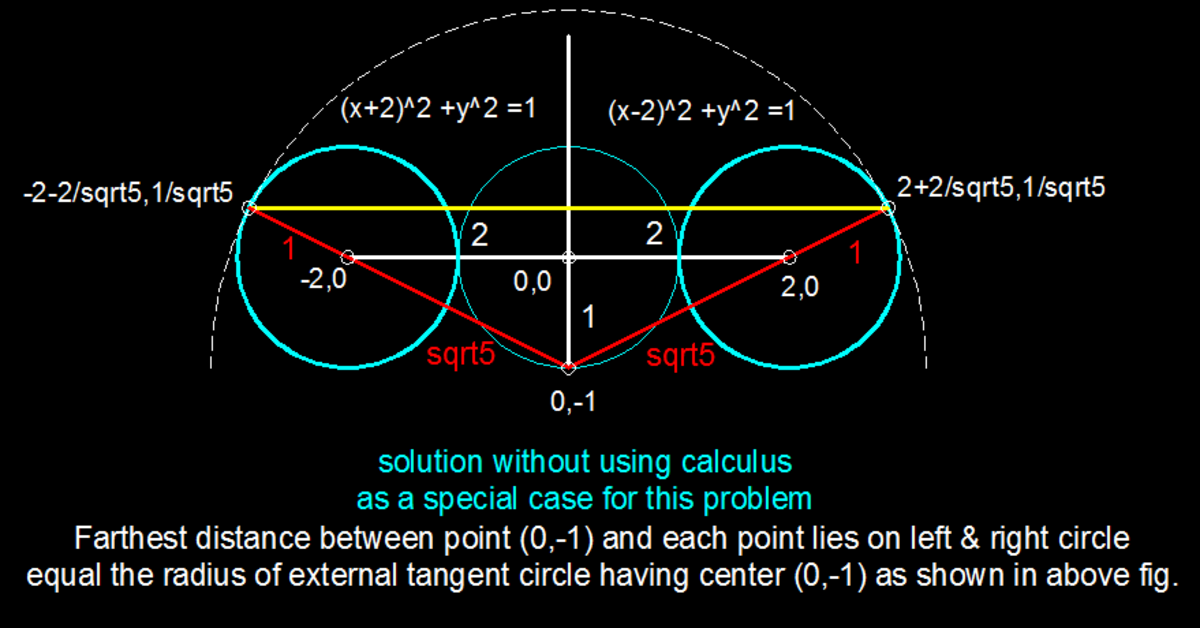The Farthest Point

Consider the three unit circles above with the first and third ones touching the middle one and all their centers on the x -axis. From the point ( 0 , − 1 ) , locate the point on each of the other circles farthest from it. Connect these three points to form a triangle .
The most simplified ratio of the area of triangle to the sum of areas of the three circles can be expressed in this form
b π a ( c + d ) ,
where a , b , c and d are positive integers with a , b coprime and d square-free. Find a + b + c + d .
The answer is 27.
This section requires Javascript.
You are seeing this because something didn't load right. We suggest you, (a) try
refreshing the page, (b) enabling javascript if it is disabled on your browser and,
finally, (c)
loading the
non-javascript version of this page
. We're sorry about the hassle.
3 solutions
We locate one of such point P ( x , y ) by means of Pythagorean Theorem, and some light maxima-minima type of calculus.
Focusing on the rightmost circle, the distance d of any point in the upper half of the circle to ( 0 , − 1 ) is determined by
d 2 = x 2 + ( 1 + y ) 2
where y = 1 − ( x − 2 ) 2
simplifying, we get
d 2 = ( 4 x − 2 + 2 1 − ( x − 2 ) 2
getting the derivative of the L.H.S with respect to x , we get
( d 2 ) ′ = 4 − 1 − ( x − 2 ) 2 2 ( x − 2 )
setting this to zero, we simplify this and get
5 ( x − 2 ) 2 = 4
x = 2 + 5 2 5
from which
y = 5 5
well, basically, we have already found half the base of the triangle, and the height (1+y). Thus, multiplying this two and we get the triangle's area! Voila, we get
A Δ = 5 4 ( 3 + 5 ) .
We just divide this by A O = 3 π and we get
1 5 π 4 ( 3 + 5 )
This gives us 4 + 1 5 + 3 + 5 = 2 7 .

The height of the triangle is 1 + 5 1 , not 5 1
Oops. I keep doing mistakes like this. Thanks for that!!! I will do the changes in my solution.
@Efren Medallo, please tell where am i wrong
Let the point farthest from (0, -1) to extreme left circle be C ( − 2 + c o s θ , s i n θ ) by using parametric coordinates.
Then other point on the extreme right circle farthest from (0, -1) must be the reflection of point C in y-axis.
So, let this point be C 1 ( 2 + c o s θ , s i n θ ) again by parametric coordinates.
So, resulting triangle has base parallel to x-axis.
We want to maximize distance between (0, -1) and C.
Which is 4 cos θ + sin θ + 6
To maximize , differentiate it and make equal to 0; we get tan θ = 4 1
So, area of triangle is
3 π 2 1 × 4 × ( 1 7 + 1 7 )
which is giving another answer.
pLease tell where i am wrong.

L e t t h e c e n t e r s b e O L , O M , O R , a n d t h e t r i a n g l e L R P , P ( 0 , − 1 ) . A r e a Δ O L O R P = 2 1 ∗ O L O R ∗ O M P = 2 1 ∗ 4 ∗ 1 = 2 . In order that L, and R be farthest, they should be on point of tangentcy to respective circles. So PR must pass through O_R, and O_RR the radius of right circle. Similarly for the left. Because of symmetry, L R ∣ ∣ O L O R . P O R = ( P O M ) 2 + ( O M O R ) 2 = 1 + 4 = 5 , a n d P R = 1 + 5 . ∴ A r e a L R P = ( P O R P R ) 2 ∗ { A r e a O L O R P } , = 5 6 + 2 5 ∗ 2 = 5 4 ( 3 + 5 ) . D e s i r e d r a t i o = 5 4 ( 3 + 5 ) ∗ 3 π ∗ 1 2 1 . ∴ a + b + c + d = 4 + 1 5 + 3 + 5 = 2 7 .
